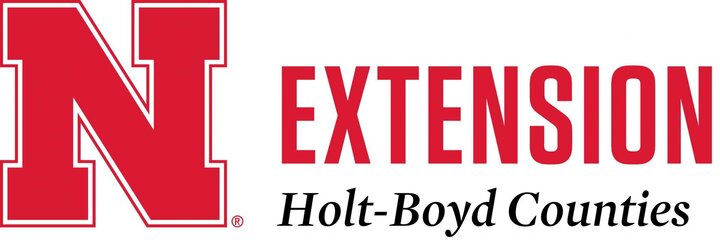
Nebraska Extension Educator - Holt & Boyd Counties - LaDonna Werth
Nebraska Extension Educator - Holt & Boyd Counties - Amy Timmerman
Nebraska Extension Educator - Holt, Boyd, Garfield, Loup, & Wheeler Counties - Bethany Johnston
Nebraska Extension Educator - Brown, Rock, & Keya Paha Counties - Brittany Spieker
Nebraska 4-H Assistant - Holt & Boyd Counties - Debra Walnofer
October 1: DUE: Clover Kid Record Books, Achievement Award Application, Diamond Clover Awards, Club of Excellence, Outstanding 4-H’er Career Award, Leader/Member Certificates in County Office
October 1: ServSafe Manager Training, 8:30am-6:00pm, Hall County Extension Office, Grand Island, NE - https://events.unl.edu/hall-county/2025/10/01/190088/
October 1: Knowing, Growing, and Grazing Grass Registration Deadline, Register at: go.unl.edu/knowing_grass
October 4: Nebraska 4-H Shooting Sports Instructor Initial Workshop, 8:00am–6:00pm, Panhandle Research Extension Center, Scottsbluff, NE - https://events.unl.edu/NE4H-Shooting-Sports/2025/10/04/189870/
October 4: Nebraska 4-H Shooting Sports Instructor Update Workshop, 9:00am–12:00pm, Panhandle Research Extension Center, Scottsbluff, NE - https://events.unl.edu/NE4H-Shooting-Sports/2025/10/04/189872/
October 5: Nebraska 4-H Shooting Sports Instructor Initial Workshop, 8:00am–12:00pm, Panhandle Research Extension Center, Scottsbluff, NE - https://events.unl.edu/NE4H-Shooting-Sports/2025/10/05/189871/
Oct 11: Nebraska 4-H Shooting Sports Instructor Update, 9:00am–12:00pm, Ashland Gun Club, Ashland, NE - https://events.unl.edu/NE4H-Shooting-Sports/2025/10/11/188974/
Oct 11-12: Nebraska 4-H Shooting Sports Instructor Training, 8:00am–6:00pm, Ashland Gun Club, Ashland, NE - https://events.unl.edu/NE4H-Shooting-Sports/2025/10/11/188969/
Oct. 13-30: Knowing, Growing, and Grazing Grass Webinar Series, Monday and Thursday evenings, 7:30pm–8:45pm CT, go.unl.edu/knowing_grass
October 26: Holt County Achievement Ceremony, 5:00pm, Faith Wesleyan Center, Atkinson, NE
November 2: Boyd County 4-H Jamboree, 2:00pm, T&S Farmstore and Food Coop, Bristow
Staying Home Alone
The start of the school year brings new routines and scheduling challenges for working parents. Any working parent can attest that school schedules and calendars were not designed with them in mind. Rightfully so, the scheduling priority should be based on the needs of the students and the educational goals of the teachers.
Each year, the extension office phone rings with the big, tough question “Is it okay for my child to stay home alone?” Nebraska, like many states, has no specific law setting a minimum age for children to stay home alone. A minimum age would be difficult to determine due to the wide-ranging maturity of developmentally average children without considering special needs.
To best determine if a child is mature enough to stay home alone, consider these factors:
- Duration - How long is the child expected to be alone? Shorter periods will be preferable to longer ones. Is there a plan in place if the duration is unexpectedly lengthened?
- Trust & Maturity - Can the child be trusted to complete assigned tasks without supervision? Is the child trusted to make reasonable decisions? Does the child feel safe and confident?
- Rules & Boundaries - Are rules established and does the child know them? Consider rules regarding knives, stoves/ovens, fire
LaDonna Werth
Extension Educator
Phone: 402-336-2760
E-mail: lwerth2@unl.edu

phones, answering doors, inviting friends or other specific concerns in the home. Are there expectations for how they spend this time?
- Emergency Preparedness - Does the child know how to respond to the emergencies relevant to the location including fire, tornadoes, flooding, power outages or criminal activity? Do they have access to a phone to call 911 or a trusted neighbor in close proximity?
If the parent and child both feel confident after making it through this list of considerations, a little practice never hurts. Start small with the child staying home during a quick errand or possibly a more extended period of time while the parent is not far away. Increasing independence is a vital stepping stone in youth development on the way to becoming a confident, decisive young adult.
To learn more about positive youth development, visit: https://4h.unl.edu/pyd/ or this article, email Jennifer Epp, 4-H Educator at jepp@unl.edu. To learn about more parenting or youth development topics, please contact your local Extension Office.
Source: Jennifer Epp - 4-H Educator (UNL For Families - September 22, 2025)
Hunting Lease Comparisons for Wild Game Across Nebraska in 2025
The Nebraska Farm Real Estate Market Survey and Report 2024-2025 provides insight into recent trends in the market value of land and cash rental across the state. Each year, the special feature section covers topics on new or emerging issues related to the agricultural land industry in Nebraska. These topics reflect the interest expressed by panel members and readership of the Nebraska Farm Real Estate Market Highlights Reports. The special feature section in 2025 focuses on hunting rental arrangements in Nebraska, including the types of wild game commonly hunted and the value associated with leasing these rights.
Landowners seeking to make additional income off their property outside of the traditional agricultural use or rental arrangements (where the hunting rights have not been granted to the tenant) may choose to lease the right to exclusively hunt certain types of wild game to a third party (Ferrell, et al. 2023). Panel members were asked to estimate the percentage of hunting leases for antelope or deer, pheasants or quail, turkey, waterfowl, and other game within their district across the state. The other game category included hunting leases for any species outside of the other identified categories.
Approximately 49% of the wild game leases in Nebraska were for antelope or deer, making this category the most popular across all districts and the state. Pheasants or quail, turkey, waterfowl, and other game constituted 17%, 13%, 19%, and 2%, respectively, of the remaining categories. The pheasants or quail category in the Northeast, Southwest, and South Districts, accounting for 21%, 29%, and
Amy Timmerman
Extension Educator
Phone: 402-336-2760
E-mail: atimmerman2@unl.edu

24% of the leases, respectively, showed a higher level of interest in these regions of Nebraska. Panel members also noted that the value of these leases may be significantly affected by the vegetation and terrain type associated with the property.
Hunting rights for turkeys received the most interest in the North, South, and Southeast Districts, accounting for 24%, 21%, and 19% of the lease comparisons. The Northwest, Central, and East Districts denoted the most significant interest for waterfowl. These regions follow portions of the Platte River and contain features highly desirable to waterfowl during periods of the hunting lease. The types of other game were not specified as part of the survey, and received the lowest responses among the five categories. In the Southwest, 7% of the hunting leases were for other game, which led to the highest response rate among the eight districts.
Different types of vegetation, conservation practices, or topography features may influence the value of a hunting lease for a specific property. The desirability of the hunting lease may be influenced by the specific combination of these features (Mengak, 2024). Properties that feature a diverse mix of these elements are often seen as offering higher quality hunting experiences. This variety might attract a broader range of hunters and increase demand or potential lease value. In competitive markets, such characteristics can significantly set one property apart from others.
Understanding the key features that drive hunting lease value helps landowners and prospective hunters make informed decisions. Figure 1 summarizes the major features contributing the most value to hunting leases across Nebraska. The most common features reported by panel members, in order, were vegetative cover, proximity to water, topography, conservation practices, and other factors at 37%, 25%, 19%, 17%, and 2%, respectively The hunting lease provisions, contract duration, and the type of wild game found on a property all affect the value of the hunting lease (Pierce & Milhollin, 2024). Recognizing these features may assist in tailoring properties to better structure hunting leases and their potential returns.
Evaluating income potential from hunting leases provides valuable insight into the rights associated with the pursuit of different types of wild game in Nebraska. Figure 2 summarizes the average annual income for leasing hunting rights on a property in Nebraska. Panel members reported the average income‑earning potential for leasing of hunting rights to agricultural leases across Nebraska in 2025. Ranked in order of income‑earning potential, these categories include $0 to $2,499, $2,500 to $4,999, $5,000 to $9,999, and $10,000 or more, with rates of 62%, 29%, 8%, and 1%, respectively. These figures show that while most properties produce modest returns, a small portion can generate higher income.
The value of an agricultural property for hunting wild game, according to panel members, depends on the hunter’s ability to gain rights to the whole parcel rather than renting on a per-acre basis. Estimating the income potential of an agricultural property per acre becomes challenging as hunters value contiguous land with distinctive geographical features that draw desired game. Properties with full access to large, uninterrupted tracts may tend to be more desirable for hunting leases. In many cases, hunting leases might provide supplemental income that supports broader use of the property throughout the year. This makes hunting rights an essential consideration for both current and future generations.
Survey results shown and discussed in this report are findings from the University of Nebraska–Lincoln 2025 Nebraska Farm Real Estate Market Survey. The survey's complete results can be found on the Nebraska Farm Real Estate website: http://cap.unl.edu/realestate/.
Please address questions regarding the 2025 Nebraska Farm Real Estate Report to Jim Jansen at (402) 261-7572 or jjansen4@unl.edu.
Source: Jim Jansen – Agricultural Economist (CropWatch – September 16, 2025)
Downed Corn: Problem or Opportunity for Cattle Producers?
When corn harvest is delayed and it's windy a lot of corn ears end up on the ground. This means a lot of energy remains in corn fields, creating potential issues with founder/acidosis. Founder can have long-term consequences of reduced cow longevity.
Opportunity: Capitalize on the grain (energy) by grazing calves.
Calves do not initially seek out ears in the field as this is a learned behavior. They are more likely to self-adapt by slowly increasing the amount of gain they consume each day. Although there is some risk of acidosis, feeding them corn and working them up to 5 lbs/calf of grain before turnout should help. Calves eating only corn grain and residue will not have enough protein in the diet to make full use of the energy available. Feeding 2 lbs of distillers can increase gain substantially and increase returns. Using the calves to glean the majority of grain and moving them from field to field before the cows may be a great way to reduce risk and make money at the same time.
Opportunity: Using cull cows to glean the fields?
Putting weight on cull cows can increase revenue and using them in corn fields ahead of the rest of the cow herd can reduce the risk of long-term negative effects of founder/acidosis in the remaining cows in the herd. It might even be worth buying thin cull cows, grazing them through, and selling fat cull cows at the end. Before turnout, producers should start feeding grain and work them up to
Bethany Johnston
Extension Educator
Phone: 402-336-2760
E-mail: bjohnston3@unl.edu

at least 7 to 10 lbs/hd of grain over a week to 10 days. Then give them access to the number of acres to limit to 10 lbs/cow for five to seven days then move to 15 lbs/cow for five to seven days (see table). After this point, they can have unlimited access to the field. These cows can be moved to the next field once most of the corn grain has been grazed. There is still risk of acidosis/founder, but it will be less with this adaptation period.
Don't want to feed grain before turn out? You can strip graze the downed ears to adapt cattle to the grain. Download the spreadsheet, input the bu/ac of down corn in the field as well as the number of animals in the group to calculate the amount of acres to allocate for various corn intake amounts.
Problem: Feeding spring-calving cows.
In addition to the concern with having cows founder or get acidosis, there is also an issue with cows getting fat. Not weaning before turnout is an option to help increase the cow's energy requirement.
The best option, regardless of whether you wean, is to limit access to corn by strip grazing daily. Those with a pivot fence can readily use this system. Allowing the pairs access to 10 lbs of corn and feeding 2 lbs of DM from distillers grains should allow the cows to maintain bodyweight and the calves to gain 1.0 to 1.5 lbs/day. If cows are weaned, limiting cows to no more than 10 lbs/day of grain will allow them to increase their body condition score (BCS) by 0.5 to 1 over the winter. Before turnout, producers should start feeding grain and work cows up to at least 7 lbs/head of grain over a week to 10 days.
If daily allotment is just not an option, the next best option is to work cows up to a full grain diet as suggested above with the cull cow feeding. However, if you are going to need to move to a new field over the winter (based on stocking rate and the amount of residue in the field), there will likely be an issue when all the grain has been grazed and the cows are eating only residue. When they are moved to a new field, they will have full access to grain again but their rumen will no longer be adapted. Thus, there are two options:
- Once cows are acclimated to full grain, they could be split into groups on multiple fields that they will graze for the rest of the winter.
- All cows could be quickly moved through all fields, allowing them to harvest most of the grain. Once most of the grain has been gleaned from all the fields, the cows can be moved back through the fields to make use of the rest of the residue.
Regardless of the class of animals grazed or the method used, providing monensin can be beneficial. If no supplemental feed is provided, using a free-choice mineral with monensin in it can help.
For information on how to estimate the amount of ear drop, see: Estimating Bushels of Corn on the Ground by Counting Ears Prior to Grazing with Cattle. For more information on using a pivot fence to limit access, see the webinar recording: Feeding Cattle Forage Using Electric Fence as a Management Tool.
Producer Question
I have a lot of downed corn ears in my field. Can I feed sodium bicarbonate either free choice or put it in the water and turn cows out to graze?
A: Most of the work with sodium bicarbonate is adding it to the diet and evaluating how it works to prevent acidosis in grain adapted animals. These animals have a population of bacteria built up that can use lactic acid, which is produced by other bacteria in the rumen when digesting corn. Thus, the sodium bicarbonate will be neutralizing mostly other acids (such as propionate and acetate) that are not as strongly acidic as lactic acid. The improvement (increase) in ruminal pH, even in these situations is inconsistent. Feeding sodium bicarbonate does sometimes increase ruminal pH and other times, it has not. The amounts tested vary. Sometimes it appears to have an effect at 1 to 1.5% of the diet, but then has not worked at that level or even higher levels, like 5% of the diet. From these experiences, using sodium bicarbonate to control even subacute acidosis is unreliable at best.
Additionally, the issue with grazing cows on downed corn is that we are essentially feeding corn to un-adapted animals. In this case, the goal is to have the sodium bicarbonate neutralize a great deal of a very strong acid (lactic acid) that is being produced. Thus, providing even high amounts of sodium bicarbonate (or other buffers) and expecting it to maintain increased ruminal pH is unrealistic.
Lastly, in the situations where we feed sodium bicarbonate, either free choice or in the water, the intake will be inconsistent and not related to the amount of corn consumed. Also, when providing it in the water some animals will be deterred from drinking.
Therefore, I would not recommend depending on sodium bicarbonate in the water or providing free choice to prevent acidosis (grain overload) when cattle are grazing downed corn. Instead, the best management practice is to adapt the rumen bacteria to corn to increase the number of lactic acid using bacteria.
Cattle that become acidotic for even a short time can have reduced performance long term due to damage to the rumen wall. Therefore, taking the time to avoid acidosis is very important.
Source: Mary Drewnoski - Nebraska Extension Beef Systems Specialist (BeefWatch – September 16, 2025)